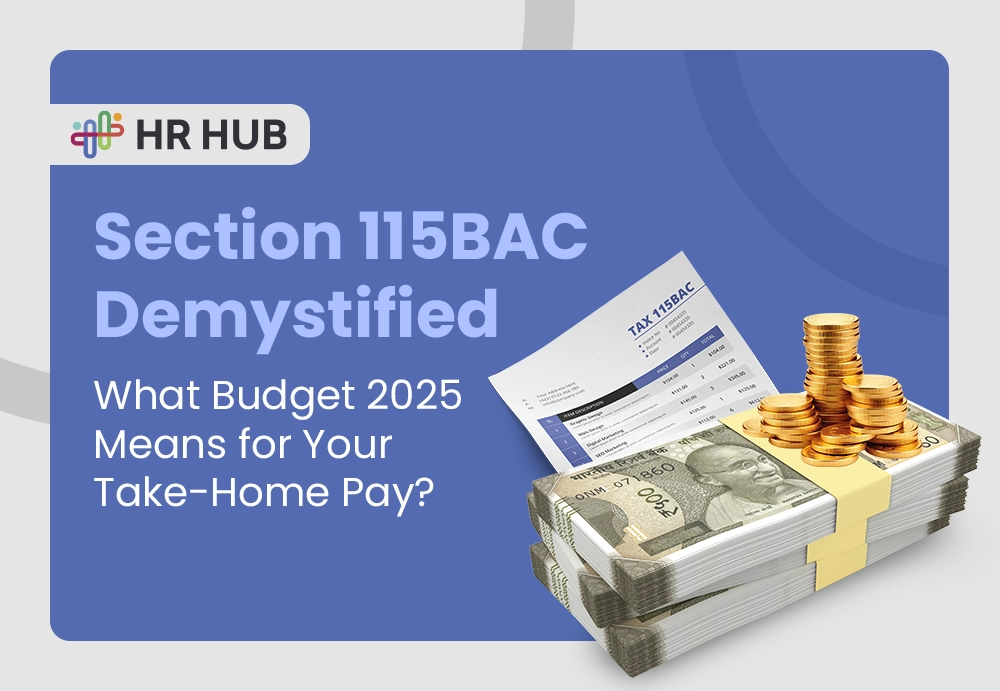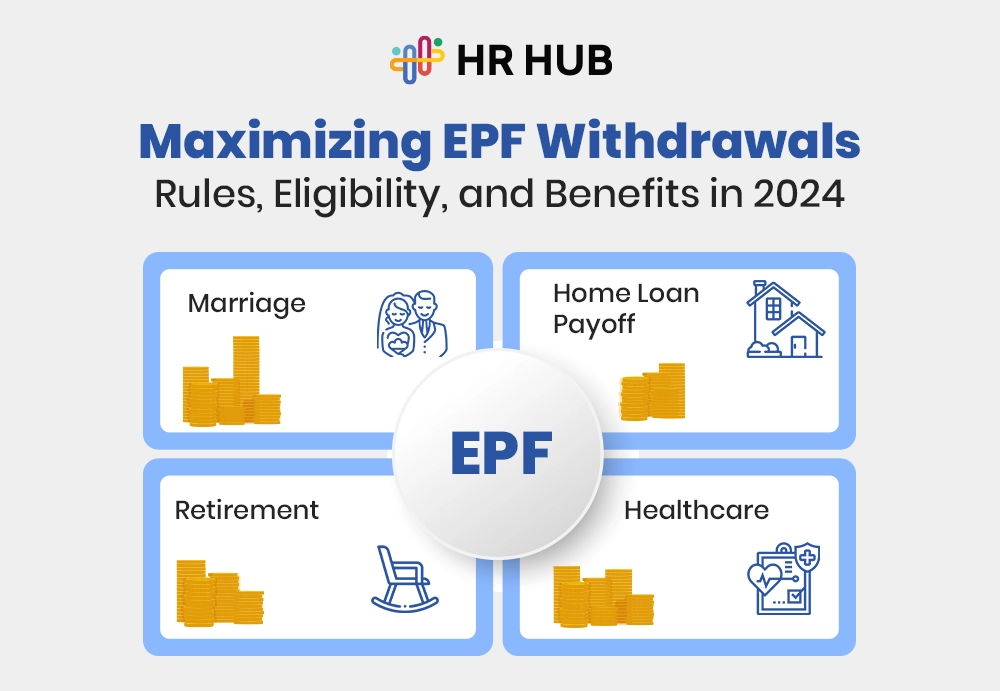


This site uses cookies to deliver our services. By using our site, you acknowledge that you have read and understand our Cookie Policy. Your use of HR HUB's services is subject to these policies.

Consider this: Your HR staff is overwhelmed by piles of attendance records, Excel spreadsheets, and anxious emails during the final week of the month. Employees are already inquiring about the arrival of their pay stubs, and there are still tasks such as processing salaries, double-checking TDS deductions, and updating PF contributions. For many Indian businesses, this end-of-month chaos feels all too familiar.
Now imagine the same situation where all calculations happen in seconds, compliance checks run automatically, and employees receive their salary slips without a single error. That’s the difference payroll software in India is creating across industries today.
At first glance, payroll looks like a simple equation: salary in, deductions out, net pay credited. But in India, payroll is layered with statutory obligations and employee-centric policies. Businesses must deal with:
When managed manually, each of these components becomes a potential risk. A small error in PF percentage, a missed TDS deadline, or an incorrect professional tax deduction can result in fines and long-drawn reconciliations. This is why the best payroll software in India has become essential, not optional.
Human-led payroll processing often suffers from inconsistencies. Financial losses and employee annoyance can result from a single, minor formula error, forgotten allowance, or improperly applied deduction. For example, a wrong formula in an Excel sheet might calculate 12% PF instead of the correct 10%, or miss out on overtime hours altogether.
With payroll processing software, businesses define salary structures, benefits, deductions, and compliance rules once, and the system applies them flawlessly every month. The software automatically accounts for variables like overtime, arrears, and reimbursements, ensuring every detail is captured correctly.
Errors don’t just affect the company financially — they impact trust. An employee loses faith in the professionalism of the company if they discover that their pay has been miscalculated. Payroll automation helps businesses maintain employee morale while removing conflicts that would otherwise take up HR's time.
Manual payroll is not just error-prone; it’s painfully slow. Traditional payroll cycles involve collecting attendance data from devices or registers, calculating allowances manually, applying tax deductions, and preparing payslips. This process can stretch across five to seven days for medium and large organizations.
Payroll automation benefits cut this cycle dramatically. Attendance data integrates directly with the payroll system, tax rules are pre-configured, and bulk payslips are generated instantly. What once took a week can now be done in just a few hours.
This speed matters because it directly affects employee satisfaction. Employees expect salaries to be credited on the exact promised date. Delays, even for technical reasons, create unrest. By ensuring timely payroll processing, businesses strengthen employee trust and improve workplace stability.
In addition, automation helps HR adapt quickly to unexpected changes — say, a mid-month hiring surge or adjustments in overtime. Instead of derailing the entire process, the system recalculates seamlessly.
Small businesses often assume payroll software is “for the big players.” In reality, payroll software for small businesses delivers the biggest impact at the smallest scale. For a startup with 15 employees, even a single payroll error can feel monumental — especially when word spreads among a tightly knit team.
By adopting payroll automation early, small companies look and operate like established enterprises. The software takes care of compliance, generates professional payslips, manages reimbursements, and keeps accurate records — all without needing a dedicated payroll officer.
For founders and managers, this means less time spent worrying about PF filings or TDS deductions and more time focused on growth. In competitive markets, professionalism in payroll can also help attract talent, as employees feel assured their financial matters will be handled transparently.
Efficiency involves reallocating resources to high-value tasks, minimizing errors, and saving time. HR specialists often spend a disproportionate amount of time on tedious payroll computations. When automation is implemented, that time can be used for performance management, training programs, workforce planning, and culture-building exercises.
This shift turns HR from a purely administrative department into a strategic partner in business growth. Instead of being bogged down by clerical tasks, Payroll data insights can be used by HR directors to improve employee experiences, control expenses, and guide hiring practices.
Efficiency doesn’t come from payroll alone — it comes from eliminating duplication of work. With modern payroll software, attendance data from biometric systems, shift schedules, or leave applications flows directly into payroll calculations. No manual imports, no risk of mismatch.
For businesses with multiple branches or rotating shifts, this integration is a game-changer. Instead of HR reconciling three different data sources, the software does it in real time. That means faster processing, greater accuracy, and zero confusion about employee working hours.
Many Indian companies operate across cities or states. Each office may have different HR staff and processes, but payroll needs to remain consistent. Payroll software standardizes calculations across locations, ensuring every employee — whether in Delhi, Bengaluru, or Kochi — receives accurate and timely pay under the same framework.
This consistency reduces internal disputes and gives leadership a consolidated view of payroll costs without wasting hours merging branch-wise reports.
Efficiency is not just internal — it also reflects in how employees interact with payroll. When staff can download payslips, view tax deductions, and access salary details on demand, the process feels smooth and professional. Employees no longer need to chase HR for basic requests, which improves satisfaction and reduces friction.
And happy employees equal a more efficient organization. Many hours of work are wasted due to delays and disagreements; everyone can concentrate on their actual tasks when there is accuracy and transparency.
India’s labor and tax laws are ever-changing. One year, PF thresholds are revised; the next, income tax rules or professional tax slabs shift. Maintaining compliance is like chasing a moving target for companies that handle payroll manually.
TDS and PF compliance software acts as a safety net. The system updates automatically with the latest statutory requirements, ensuring that deductions, contributions, and filings are always accurate. Businesses no longer need to manually reconfigure tax formulas or worry about whether their payroll aligns with current regulations.
For organizations spread across multiple states, this becomes even more important. Professional tax rates vary regionally, and payroll software applies the correct rate based on employee location, removing guesswork and reducing risk.
The Indian payroll calendar is dotted with deadlines — PF deposits by the 15th, ESI contributions, TDS filings at quarterly intervals, and more. Missing even one can invite penalties, interest, and legal consequences.
Payroll software doesn’t just calculate correctly; it manages deadlines proactively. Through reminders, alerts, and automated workflows, HR and finance teams are nudged well in advance of due dates. Compliance ceases to be reactive and becomes a smooth, scheduled process.
This also provides peace of mind to business owners. Instead of micromanaging statutory tasks, they can focus on expansion, knowing their payroll system will flag every important date.
Audits — whether internal or statutory — often reveal the weakest links in manual payroll processes. Missing payslips, inconsistent deduction records, or scattered compliance filings can turn audits into nightmares.
With payroll software, every entry is timestamped and stored securely. With a single click, you can access reports on TDS deductions, PF contributions, gratuity payments, and reimbursements. HR doesn't waste weeks gathering files, and auditors receive data that is clear and organized.
For businesses operating across multiple states, professional tax and labor law variations are a major challenge. Payroll software automatically applies the correct tax slabs and compliance rules based on the employee’s work location. This ensures accuracy without forcing HR teams to track state-wise changes manually.
Government authorities often require detailed reports — from monthly PF summaries to quarterly TDS filings. These reports are automatically generated by payroll software in formats that comply with legal requirements. This guarantees consistency in reporting during inspections and cuts down on the amount of time spent preparing documents.
In India, noncompliance can result in severe consequences, such as fines and harm to one's reputation. Payroll software acts as a safeguard by ensuring timely filings and accurate calculations. By reducing dependency on manual updates, it minimizes the chances of human oversight that could result in legal trouble.
Compliance isn’t only about PF and TDS — it’s also about data protection. Payroll software ensures compliance with India's data privacy laws and safeguards confidential employee information by preventing salary or tax data leaks. By using encryption and role-based access, companies can reassure employees that their financial data is safe.
Efficiency and compliance are only two aspects of payroll automation. It changes how leaders and employees perceive payroll, which has repercussions throughout the company.
The days of workers waiting in line outside HR cabins to pick up tax forms or pay stubs are long gone. Employees can download pay stubs, update bank information, declare investments to save taxes, and even independently track leave balances with self-service portals. This reduces the workload for HR while providing workers with more transparency.
Payroll software integrates smoothly with biometric devices, attendance systems, and broader HR modules. By doing this, duplicate data entry is avoided, and salary computations are guaranteed always to use accurate attendance and leave data. For example, if an employee takes a half-day, it’s reflected automatically in their monthly salary calculation.
Employee payroll information is sensitive — salary details, tax information, and banking records must be safeguarded. Payroll software protects this data with encryption, secure servers, and role-based access. Only authorized personnel can access critical information, reducing the risk of leaks or misuse.
Payroll is a goldmine of data. Automation can be used by businesses to monitor departmental expenses, overtime costs, and attrition payouts. This information can be used to inform strategic decisions such as adjusting staffing levels, monitoring overtime laws, or improving budget planning.
For example, payroll analytics were used by a multi-location retail chain to find that overtime expenses were disproportionately higher in one branch. Through their investigation, they found scheduling inefficiencies and reorganized shifts, which resulted in annual savings of lakhs.
Payroll no longer needs to be a pain point. With payroll software in India, businesses gain accuracy, compliance, speed, and peace of mind. From small firms to large corporations, the shift to digital payroll is transforming not just efficiency but also employee trust and organizational credibility.
This is where HR HUB steps in. HR HUB’s payroll module is built specifically for Indian businesses, combining automation with local compliance expertise. From salary calculations and investment declarations to TDS and PF filings, HR HUB ensures payroll runs effortlessly while meeting every statutory requirement. With features like employee self-service, attendance integration, and audit-ready reporting, HR HUB transforms payroll from a monthly stress point into a strategic advantage.
For businesses aiming to grow without being weighed down by compliance headaches, HR HUB is not just a payroll tool — it’s a partner in creating a smarter, more efficient workplace.



Ready to streamline your HR processes? Contact us today to learn how HR HUB can help your organization thrive. Fill out the form, and one of our experts will reply shortly. Let's empower your workforce together!
